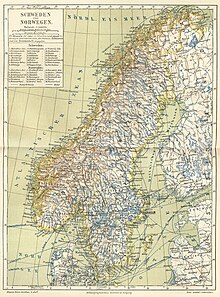Scandinavian peninsula
| Scandinavian peninsula | ||
| Geographical location | ||
|
|
||
| Coordinates | 63 ° N , 14 ° E | |
| Waters 1 | Baltic Sea | |
| Waters 2 | North Sea | |
| Waters 3 | European Arctic Ocean | |
| Waters 4 | Barents Sea | |
| surface | approx. 800,000 km² | |
The Scandinavian Peninsula (Swedish. Skandinaviska halvön ; norweg. Skandinaviske halvøy ; fin. Skandinavian niemimaa ) is a peninsula of Europe that extends from Skåne in the south to the North Cape in the north. The Scandinavian Peninsula is home to Norway and Sweden and most of Lapland in northern Finland . The Scandinavian Mountains usually define the border between Norway and Sweden. A demarcation of Scandinavia to the Kola peninsula and the border within Finland must be drawn arbitrarily.
The name is derived from the term Scandinavia , which culturally mostly includes Denmark , Sweden and Norway. This name in turn is derived from the name Skåne , the southernmost part of the peninsula, which today belongs to Sweden, but belonged to Denmark until the 17th century and is the original home of the Danes .
Classification in Europe
The Scandinavian peninsula is, if one does not want to define it only as part of the Fennoskandia peninsula , the largest peninsula in Europe, which is itself a peninsula of Eurasia . However, the area cannot be precisely determined because the boundaries of the peninsula are not clear. At times Scandinavia was not a peninsula. During the Ice Ages, the sea level fell so much that the Baltic Sea , the Gulf of Bothnia and the Gulf of Finland disappeared. Today's countries like Germany , Poland and the Baltic States were directly connected to Scandinavia by land.
geography

The Scandinavian Peninsula is around 1850 kilometers long with a width varying from around 370 to 805 kilometers. About a quarter of the Scandinavian Peninsula is north of the Arctic Circle . The northernmost point is on the headland Kinnarodden on the North Chin Peninsula .
In the west is the Norwegian fjord coast , in the south are the large lakes Vänern and Vättern . In front of the coast are small rock islands, the archipelago .
The peninsula is bounded by four large bodies of water:
- the Baltic Sea (including the Gulf of Bothnia ) in the east with the autonomous Åland Islands between Sweden, Finland and Gotland ,
- the North Sea in the southwest (with the Kattegat and Skagerrak in the south),
- the Norwegian Sea in the west,
- the Barents Sea in the north.
The highest point was Glittertind in Norway with 2,470 m above sea level. Since the glacier has partially melted at the summit, Galdhøpiggen , 2,469 m , is the highest point, also in Norway. These mountains also have the largest glacier on mainland Europe, Jostedalsbreen .
The region is rich in wood, iron, copper and has the best arable land in Sweden. Large oil and gas deposits off Norway's coast have been found in the North Sea and the Atlantic.
Most of the population of the Scandinavian Peninsula lives in the southern part, which is an agricultural region. The largest cities on the peninsula are, in descending order, Stockholm , Oslo , Gothenburg , Malmö and Bergen .
climate
Various climatic zones can be distinguished in Scandinavia:
- Tundra ( Köppen : ET) and subarctic climate (Dfc) in the north,
- cool west coast climate (Cfc) in the northwest (coastal areas north of Lofoten ),
- humid continental climate (Dfb) inland,
- more moderate rainy climate (Cfb) on the coast in the south and south-west.
Residents
The first recorded human presence in the southern area of the peninsula and Denmark dates back to 12,000 years ago. When the ice sheets thawed after the last ice age, the tundra and its typical inhabitants were able to expand into the now ice-free areas. So the people who lived on reindeer hunting back then followed the large herds of reindeer. The climate gradually warmed up and favored the growth of conifers first, then that of deciduous forests , which brought animals such as aurochs with them. Groups of hunter-fisher-gatherers began to populate the area from the Mesolithic (8200 BC) to the advent of agriculture in the Neolithic (3200 BC).
The northern and central part of the peninsula is partly inhabited by Sami , often referred to as "Laplanders" or "Laplanders". They speak Sami languages that are related to Finnish and Estonian . The Sami languages are not Indo-European languages , they belong to the Uralic languages . In the 9th century, when written records began, the Sami occupied the arctic and sub-arctic regions, but also the central part of the peninsula south to Dalarna in Sweden.
The other inhabitants of the peninsula spoke Old Norse dialects at that time . Norwegians lived on the west coast of Norway, Danes in the south and west of today's Sweden, Swedes in Västergötland and Östergötland , in the region around the Mälaren and on the east coast of Sweden. The descendants of this population are still the dominant population in the early 21st century.
See also
Individual evidence
- ↑ Nordic FAQ Geography of Sweden
- ^ Glossary of American climate terminology in terms of Köppens classification
- ^ Tilley, Christopher Y. Ethnography of the Neolithic: Early Prehistoric Societies in Southern Scandinavia , p. 9, Cambridge University Press. 2003. ISBN 0-521-56821-8
- Jump up ↑ Sawyer, Bridget and Peter: Medieval Scandinavia: from conversion to Reformation, circa 800-1500 1993, ISBN 0-8166-1738-4 .



